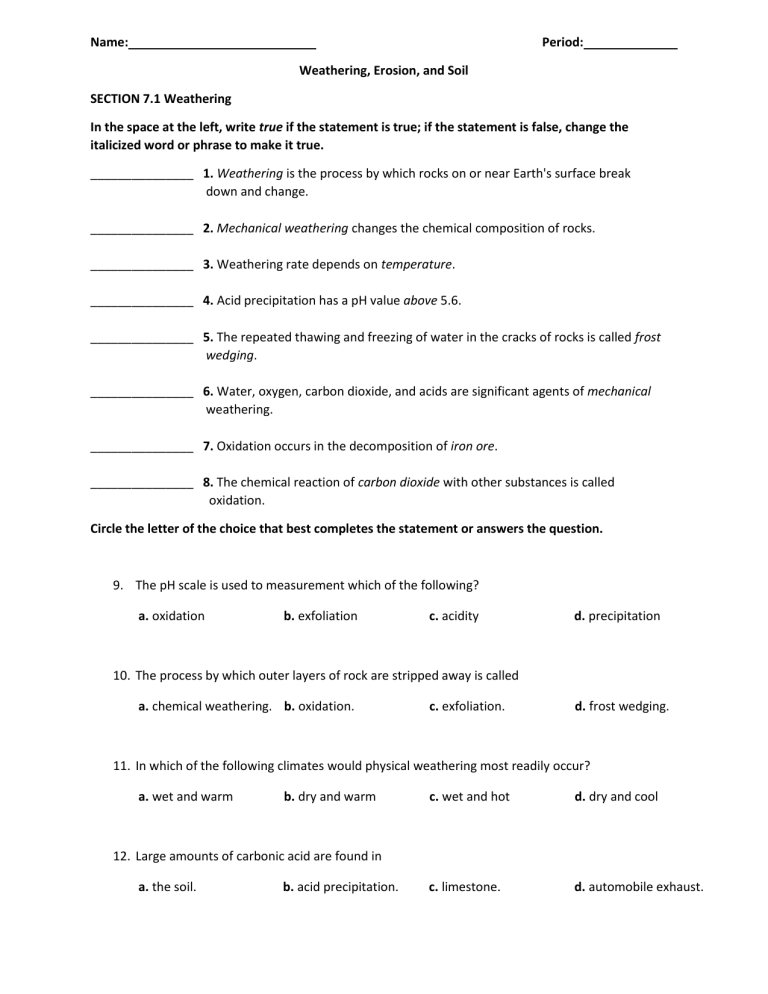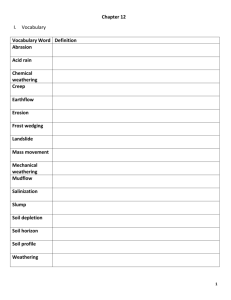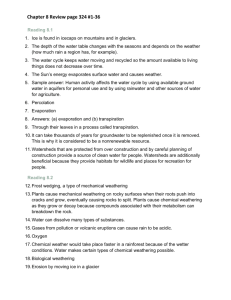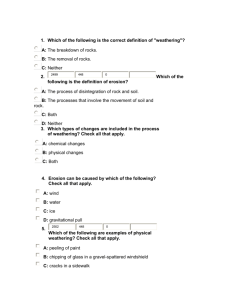Name: Period: Weathering, Erosion, and Soil SECTION 7.1

Name:
Weathering, Erosion, and Soil
Period:
SECTION 7.1 Weathering
In the space at the left, write true if the statement is true; if the statement is false, change the
italicized word or phrase to make it true.
_______________ 1. Weathering is the process by which rocks on or near Earth's surface break
down and change.
_______________ 2. Mechanical weathering changes the chemical composition of rocks.
_______________ 3. Weathering rate depends on temperature.
_______________ 4. Acid precipitation has a pH value above 5.6.
_______________ 5. The repeated thawing and freezing of water in the cracks of rocks is called frost
wedging.
_______________ 6. Water, oxygen, carbon dioxide, and acids are significant agents of mechanical
weathering.
_______________ 7. Oxidation occurs in the decomposition of iron ore.
_______________ 8. The chemical reaction of carbon dioxide with other substances is called
oxidation.
Circle the letter of the choice that best completes the statement or answers the question.
9.
The pH scale is used to measurement which of the following?
a. oxidation b. exfoliation c. acidity d. precipitation
10.
The process by which outer layers of rock are stripped away is called
a. chemical weathering. b. oxidation. c. exfoliation. d. frost wedging.
11.
In which of the following climates would physical weathering most readily occur?
a. wet and warm b. dry and warm c. wet and hot d. dry and cool
12.
Large amounts of carbonic acid are found in
b. acid precipitation. a. the soil. c. limestone. d. automobile exhaust.
13.
Buildings and monuments that are made of limestone are greatly damaged by
a. freezing. b. acid precipitation. c. oxidation. d. frost wedging.
14.
Which of the following factors does NOT exert pressure on rocks that leads to physical weathering?
a. plant roots b. overlying rocks c. freezing water d. carbonic acid
Use the terms below just once to complete the passage.
water acid precipitation carbonic acid carbon dioxide
temperature mechanical composition pressure
The process by which rocks and minerals break down into smaller pieces is (16) _______________ weathering, also called physical weathering. Two factors that play a significant role in this type of weathering are (17) _______________ and (18) _______________. To some extent, the
(19) _______________ of rocks determines the effects that chemical weathering will have on them.
(20) _______________ is an important agent in chemical weathering because it can dissolve many kinds of minerals. An atmospheric gas that contributes to the chemical weathering process is
(21) _______________, which is produced by living organisms. When this gas combines with water, it produces a weak acid called (22) _______________. Another agent of chemical weathering is
(23) _______________, which is caused mainly by emissions of sulfur dioxide and nitrogen oxides.
Answer the following questions.
24.
What climate conditions promote chemical weathering?
25.
What rock type is most easily weathered? Why?
26.
How is surface area related to weathering?
27.
How does slope affect the rate of weathering?
SECTION 7.2 Erosion and Deposition
For each item in Column A, write the letter of the matching item in Column B.
Column A Column B
__________ 1. The final stage of the erosional process in which materials are dropped in
another location
__________ 2. The force that tends to pull all materials downhill
__________ 3. The steeper the __________, the greater the potential for flowing water to
erode earth materials.
__________ 4. Coastal areas undergo erosion by __________ and wind.
__________ 5. Erode by scraping, gouging, and picking up large rocks and debris piles
__________ 6. A major erosional agent in areas with limited precipitation and high
temperatures a.
b.
c.
slope ocean waves wind d.
glaciers e.
gravity f.
deposition
Answer the following questions.
7.
Give two examples of how plants and animals move Earth's surface materials from one place to another as they carry on their life processes.
8.
Describe the formation of barrier islands.
The following statements list types of erosion. Using the numbers 1-4, label them by their ability to
transport materials.
_______________ 1. wind erosion
_______________ 2. water erosion
_______________ 3. glacial erosion
_______________ 4. plant and animal erosion
For each statement below, write true or false.
_______________ 5. When a river enters a large body of water, the water generally slows down and
deposits large amounts of sediments.
_______________ 6. The Nile Delta was formed from ocean waves and currents.
_______________ 7. The constant movement of water and the availability of accumulated weathered
material creates continuous erosion.
_______________ 8. Unlike water, glaciers do not move material over a long distance.
_______________ 9. Wind is a major erosional agent in areas on Earth that have both limited
precipitation and high temperatures.
_______________ 10. Wind barriers are trees and other vegetation planted perpendicular to the wind
direction.
_______________ 11. The movement of soil and other Earth materials by humans as they build
highways and bridges, is not considered erosion.
_______________ 12. Barrier islands, which form from offshore sand deposits, can continue to be built
up from sediments and form sandbars.
_______________ 13. The continued erosion of rill channels can develop into gully erosion.
_______________ 14. Winds cannot blow against the force of gravity.
_______________ 15. Wind can always move more material than water.
_______________ 16. A U-shaped valley indicate that glacial erosion has taken place.
_______________ 17. Waves, tides, and currents are responsible for erosion of islands.
SECTION 7.3 Soil
Complete each statement.
1.
_______________ is the loose covering of weathered rock particles and decaying organic matter overlying the bedrock of Earth's surface.
2.
Soil that is located above its parent material is known as _______________.
3.
Soil that has been moved away from its parent bedrock is called _______________.
4.
When heavy machinery digs out soil in the process of building a road, a vertical sequence layers of soil, called a(n) _______________, will often be exposed.
5.
A distinct layer, or zone, located within a soil profile is known as a(n) _______________.
6.
Soils formed in dry, hot areas with low rainfall are classified as _______________.
7.
A(n) _______________ is a type of soil that forms in a prairie environment.
8.
The layer of a soil which is composed of humus and leaf litter is called the _______________ horizon.
9.
Soil forms as a result of _______________ and biological activity that breaks down and changes soil materials over long periods of time.
10.
The relative proportions of particle sizes make up a soil's _______________.
11.
Soil _______________ is the measure of how well a soil can support the growth of plants.
Complete the soil profile by filling in the horizons. Then answer the questions.
15.
Which horizon is the surface layer? Describe it.
16.
Which horizon is the subsoil? Describe it.
17.
Which horizon occurs directly above bedrock? Describe it.







